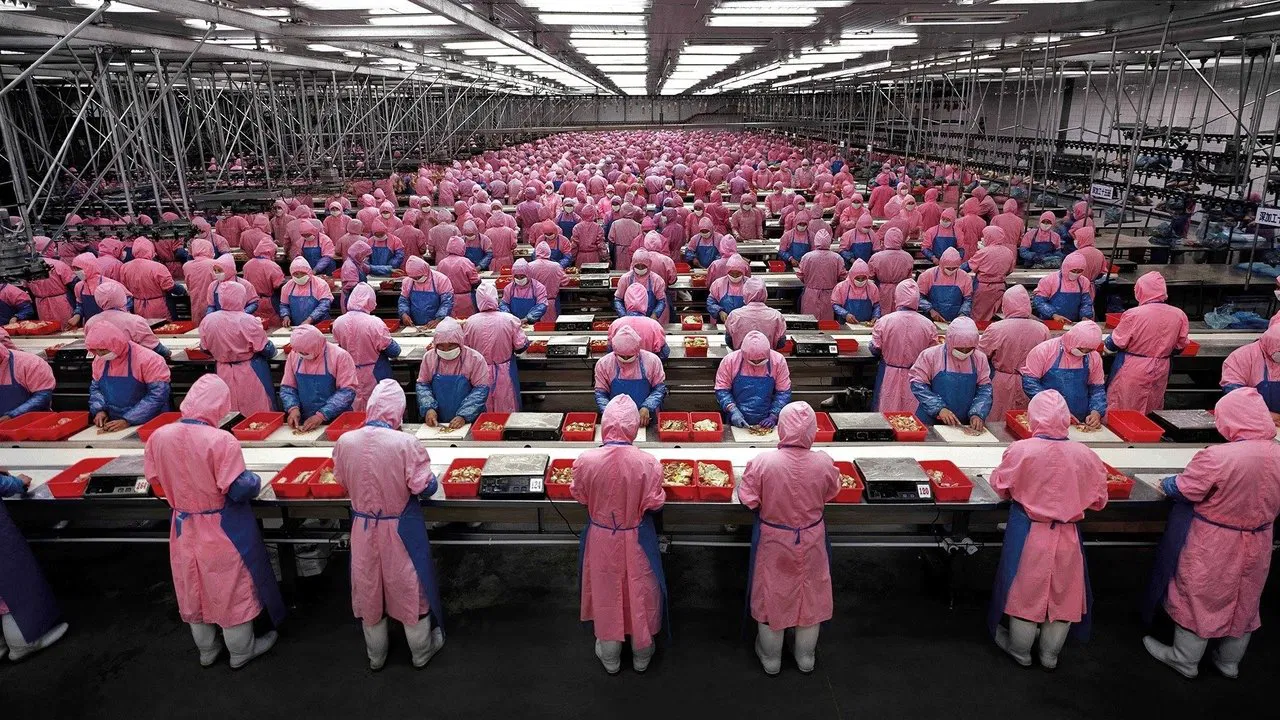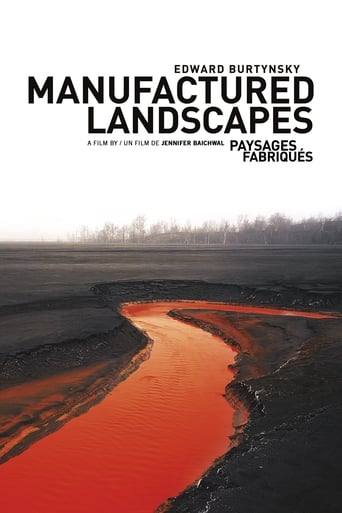

Excellent, a Must See
... View Morebrilliant actors, brilliant editing
... View MoreThe biggest problem with this movie is it’s a little better than you think it might be, which somehow makes it worse. As in, it takes itself a bit too seriously, which makes most of the movie feel kind of dull.
... View MoreOne of the best movies of the year! Incredible from the beginning to the end.
... View MoreEdward Burtynsky is a Canadian photographer who makes art out of the least "artful" objects imaginable. Everyday items such as crates, boxes, metal containers, etc. - items which most of us perceive as utilitarian at best and dismiss as being utterly without aesthetic merit - are instead converted into glorious objects d'art by Burtynsky's camera. He achieves this result by focusing on the recurring colors and geometric patterns that are apparently ever present in the industrialized world - for those perceptive enough to spot them, that is. Even heaps of compacted trash can become objects of beauty when seen through Burtynsky's lens (but didn't we already know that from "Wall-E"?). He is particularly interested in photographing areas like mines and shipyards where Man has already made incursions into nature - which may explain why at times even the people in his pictures (i.e. the workers in those places), with their uniform clothing and robotic movements, become part of the industrial landscape."Manufactured Landscapes," a documentary about Burtynsky's work, has much of the feel of a "Koyaanisqatsi" about it as it dazzles us with its richly variegated kaleidoscope of images and patterns. Indeed, director Jennifer Baichwal and cinematographer Peter Mettler capture the essence of the original photos in purely cinematic terms, as their own camera records Burtynsky and his assistant running photo shoots at a factory in China, a dockyard in Bangladesh, and the construction site at the massive Three Rivers Gorge Dam project in China. With their fluid camera-work, the filmmakers match point-for-point the beauty of Burtynsky's images. In fact, the movie opens with a stunning eight-minute-long tracking shot of a Chinese factory in which hundreds of similarly dressed workers toil away in perfectly symmetrical and color-coordinated rows.The movie does less well when Burtynsky gets around to articulating the "themes" of his work, which, quite frankly, come out sounding confused, contradictory and decidedly half-baked at best. But it is as a purely aesthetic experience, highlighting image and form, that "Manufactured Landscapes" resonates most. In the case of Burtynsky, perhaps, a picture really IS worth a thousand words.
... View MoreEdward Burtynsky is a Canadian photographer, especially famous for his depictions of industrial landscapes. His work has granted him cult-like devotion from his mostly local fans until this film was released last year. While his work isn't in the mainstream chic, it has gained a much larger following than it had previously. The film Manufactured Landscapes is a collection of Burtynsky's photos of the industrial countryside of China and other places.Edward's photos are renowned for the subliminal beauty they contain. Nevertheless, this beauty doesn't translate well to the motion-picture format. While the images are breathtaking, they are strewn together with little expository commentary. The images are supposed to relate to the descriptions Edward provides and they do most times. However, not all images are explained sufficiently. I wouldn't expect all the images to receive commentary, but descriptions near the bottom of the screen would have aided the film in effectively communicating as the book does (I feel able to include this statement given that Burtynsky has published a print version of the film).Baichwal employs a naturalistic approach to film-making. Her camera work is reminiscent of hand-held work of Cannibal Holocaust and The Blair Witch Project. The dialog, presumably between Burtynsky and his crew (or locals from his current location) is realistic and perhaps unscripted. The film has no plot, protagonists, nor created sets. So as you may imagine, it is able to progress forward in any direction it chooses. While this approach is unique, it isn't very effective. The pictures appear quickly and Burtynsky discusses them, then he moves to another location (usually in China) and interviews residents or presents new photographs. The audience is forced to rely on the images themselves to convey Baichwal's and Burtynsky's joined message. The images appear consecutively, and mimic the process of viewing them in a book, but without knowledge of their identity, which lessens their effect. I must also admit that Baichwal does provide a large collection of images of modern China, regardless of how overwhelming it may be. While I wish the film did not move to so many places in favor of many photographs of one place, this technique is inconsequential. Edward mentions that he wishes to portray China's new identity as an objective observer. It has no political stance. Manufactured Landscapes is a wonderful example of the necessary distinction between enthusiasm and skill. Edward Burtynsky's photographs are provocative and Baichwal appears to appreciate his photos but this material isn't able to translate into a ninety minute film. The material is not adapted properly into its new artistic format. The images are the focus, when the film format would encourage Burtynsky to discuss his work. The photographs are rightly given full attention in a print source. Perhaps the motion picture would have succeeded in this transition if Burtynsky had described his experiences with references to the images. Their stark appearance on screen is a microcosm of the film's unfortunate ineptitude. P.S. I was able to locate a copy of the Manufactured Landscapes picture book, and I give it my heartiest recommendation.
... View MoreBeginning with its long opening shot of seemingly endless rows of assembly line workers in a Chinese factory, Manufactured Landscapes attempts to show the devastating impact of industrialization on the natural environment and traditional societies. Its droning narrative assumes that industrial development in China and elsewhere is entirely unprecedented, as if there had never been an industrial revolution in Europe and America and Karl Marx had never visited the British Museum. That there might be a connection between the present-day Asian drive for industrialization and wealth and earlier experiences of starvation and terror is never mentioned.At the same time, there's an effort to present Edward Burtynsky's photographs of industrial waste as somehow "beautiful". Much of the film is a slide show of these images. They are well produced, of museum size, and have apparently appeared in several exhibitions. To me, however, they only demonstrate that almost any photograph can be made to appear beautiful if well presented. Industrial waste is still industrial waste. The relationship, if any, between the photographs and the film's spoken message remains unclear.I don't mean to imply that there aren't real and sometimes desperate problems when countries rush to industrialize. Manufactured Landscapes, however, offers only strange and bitter hopelessness. It's like a two-hour lecture by Noam Chomsky. Maybe it has some value as a demonstration of what's wrong with the American (and Canadian) Left.
... View MoreReviewed at the World Premiere screening Sept. 9, 2006 at the Isabel Bader Theatre during the Toronto International Film Festival (TIFF).This had an interesting premise but seemed to go on too long with too many shots of piles of eWaste (recycled computers, keyboards, cables etc. shipped over to China by the ton and then sorted and remade into new products to sell back) and other desolation.The filmmakers tried to get more people interviews to boost the human element but were frequently prevented from doing so due to Chinese censorship. Still, what was there was interesting. The bits of a Shanghai high end real estate agent preening and strutting around showing off her luxurious mansion and gardens, intercut with the scenes of others living in medieval conditions were especially striking. The opening tracking shot of a 480m factory floor was quite something as well. Scenes of the activity at the Three Gorges Dam project were also a complement to the Jia Khang-je films at TIFF (the feature Still Life/Sanxia Haoren & the documentary Dong) which were also built around that subject.Director Jennifer Baichwal, Producer Nick de Pencier, Cinematographer Peter Mettler and subject Edward Burtynsky were all there on stage for a Q&A after the world premiere. Producer Noah Weinzweig was introduced from the audience and was thanked as the most key person that assisted in the on the ground access in China itself.
... View More